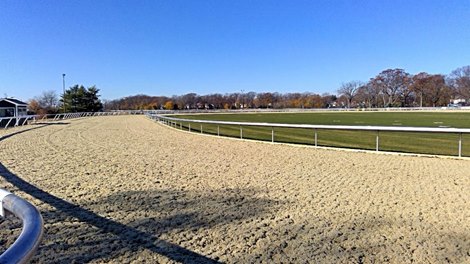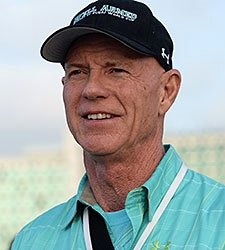Dirt racing is safer than ever, but still three times more threatening than synthetic racing.
The Jockey Club's Equine Injury Database shows that 1.44 horses per 1,000 starts died in dirt racing last year, the lowest rate in the EID's 14-year history. However, with a simultaneous fatality rate of 0.41 recorded on synthetic tracks, the safety gap between the two surfaces is greater than ever.
Overall, progress is clearly observable. Pre-race inspections are stricter, the recent regulations are more restrictive and fewer horses have died per start during the race than at any time since the database was introduced in 2009. Yet racing continues to suffer from the profound image problems caused by fatal accidents in horses remains hesitant to accept changes that make compelling sense from a statistical point of view.
Nine North American routes already had synthetic surfaces in 2009. Only five currently have synthetic surfaces, and a sixth is planned Belmont Park in 2024. When this space is added, Belmont will join Gulfstream Park offering dirt, turf and synthetic racing.
“We are an ostrich industry,” said Bill Casner, former chairman of the Thoroughbred Owners and Breeders Association. “People want to bury their heads. They don't want to recognize our problems. They want everything to continue like this and that’s not going to happen.”
Sign in Blood horse Daily
Bill Casner
“It is an opportune time. Drastic times require drastic changes. We’re fighting for survival right now.”
Casner, co-owner of WinStar Farm when the company ran the 2010 Kentucky Derby (G1) winner Super saver is a long-time proponent of plastics, whose arguments were recently echoed by owner and former Novel York Racing Commission chairman Earle Mack and, at least temporarily, by NBC's Donna Barton Brothers.
“We must abandon venerable norms and adopt recent practices that prioritize the safety and well-being of our noble equestrian athletes,” Mack wrote in an editorial for TDN. “The benefits of synthetic chains are not mere conjecture; they are a proven truth. Their superior safety record and fewer injuries make their adoption not just an option, but an ethical imperative.”
“Mack is right,” Brothers tweeted on June 1. “And it has to start with this.” Churchill Downs. If those of us at the end of our long and successful careers in horse racing do not push for change, the younger generations who follow us will find themselves in a dead end.”
Five days later, the former jockey revealed she had backed out due to additional input, saying: “More can be achieved by deepening the surface and even measuring HRV (heart rate variability) in horses.”
For supporting evidence that dirt can compete with synthetics, see sea, KeenelandAnd Santa Anita Parkwho initially had above-average mortality rates after abandoning synthetic surfaces (at an alarming rate in Santa Anita), but have recently shown that dirt paths need not be so problematic. Although the EID database does not include horses that died due to training failures, there was only one fatal off-road racing accident out of 6,406 starts at the three tracks last year – a fatality rate of 0.16 per 1,000 starts.

The renovated pony track at Belmont Park with synthetic Tapeta surface.
This almost mirrors the success of Gulfstream's recent Tapeta track, which lost one horse in 7,085 synthetic starts in 2022, a fatality rate of 0.14. In fact, Del Mar hasn't lost a horse in a dirt race since 2020.
“One is too many, but it was awfully good,” said Del Mar CEO Joe Harper. “The only way to appease the media is to stop killing horses, and I think we have a great effort undertaken to achieve this.”
Harper was quick to advocate the safety benefits of plastics when they were first introduced and refused to make any changes to the track, despite a dispute in 2007 with Ahmed Zayat, the eventual owner of American Pharaoh . But the inconsistency of Del Mar's polytrack surface between morning practices and afternoon races, its gradual deterioration and Santa Anita's move back to dirt helped Harper reconsider his position. He attributes Del Mar's recent safety record to recent testing protocols and procedures that have discouraged owners and trainers from racing at-risk horses.
“The fit ones don’t break,” Harper said. “It’s the ones who have a (pre-existing) problem. We thought, 'Let's take a closer look at them.' We sent a number of veterinarians to the track to observe these horses. That did a lot to change the culture with riders using fit horses, not “I can get another one out of him.”
Perhaps it's a coincidence, but Kentucky veterinary records indicate a recent escalate in the number of pre-race scratches at Churchill Downs. KeenelandAnd Turfway Park. Turfway veterans scratched 128 horses at the track's 2023 winter meet, more than double the number last year. More recently as a morning favorite Strength suffered a scratch on the morning of the 2023 Kentucky Derby (G1), trainer Todd Pletcher attributed the decision to increased vigilance by veterinarians.
“It’s a complex decision,” Pletcher said. “Obviously we are in an environment where control is extremely high. I'm not sure that would have been a problem in some years. But this year it was.”
Given the deaths that followed – two on the derby card; A total of 12 in a month-long period at Churchill Downs — it was difficult to argue against excessive caution. Yet there is a part of racing that sees the sport as inherently risky, horse deaths as an inevitable side effect, and synthetic tracks as an ill-advised attempt to appease animal welfare groups.
“The number (of deaths) will never be zero and bad timing will always undo even the biggest improvements,” said retired coach Charles Simon, host of the “Going In Circles” podcast. “Those who scream that racing is inhumane will not be swayed by fewer injuries. We don't even address the impact (synthetic tracks) have on the bloodstock market/breeding industry and racing's betting customers, or the enormous costs that many of the lower-level racing sports incur.” Multi-level tracks would require the installation of a synthetic track.
Ellis Parkonly a few tracks could easily absorb these costs.
“I believe, based on all the data I have seen, that Tapeta 10 is state-of-the-art, the safest racing surface available commercially,” said Jeff Platt, president of the Horseplayers Association of North America. “But it’s not affordable either and you have to upgrade every few years. This is a huge investment (and) the industry is not attracting recent customers as quickly as it did 10 years ago.”
The fear expressed by many riders is that the death of horses drives away customers and provides ammunition to those who would abandon the sport. The recurring question is whether industry insiders who oppose plastics could hasten racing's demise.
“In horse racing it often takes a long time to change our minds, doesn't it?” said Joan Wakefield, vice president of Tapeta Footings. “My concern is if something doesn’t happen, I honestly don’t know where it will take the industry.”
“I have friends who aren’t horse players,” Platt said. “A very close friend of mine said to me, ‘How do you reconcile the horse death at Churchill Downs? How are you different from Michael Vick, who supports dog fighting?' … It hurts a little, and how can that be reconciled? Look at what happened to dog racing. They had it on the ballot and it had no chance. In any state in the US it would be a massive deal outnumbering all others.
Most of the time, thoroughbred racing resembles more of a plutocracy than a democracy, and the interests of the affluent and powerful do not always align with those of the average citizen or even each other. Although the perception remains that those who invest heavily in dirt stallions have proven to be a formidable obstacle to synthetic horses and their employ in the Breeders' Cup, Thoroughbred Owners and Breeders Association President Dan Metzger said the characterization was “somewhat unfair” and that his organization had done so. No formal position on plastics.
“We have long held that all decisions regarding track surface material are solely the responsibility of the racetrack,” a Breeders' Cup spokeswoman said. “Our site selection standards require that host railway routes have protected, fair and consistent surfaces. We are working with host railroad routes and industry experts to ensure these goals are achieved.”
Multiple messages left for Churchill Downs executives were not immediately returned.
“Churchill is the hub because of the Kentucky Derby,” Casner said. “The traditionalists have resisted changing this surface because it has always been dirt. (But) What does that mean if the Kentucky Derby is canceled, which could very well happen?”
“A bill has been introduced in California to ban horse racing. It wasn’t well received at the time, but the fact that such a dialogue even exists is shocking.”


